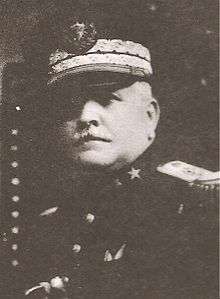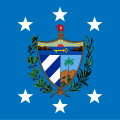Alberto Herrera y Franchi
| General Alberto Herrera | |
|---|---|
 | |
| President of Cuba Interim | |
|
In office 12 August 1933 – 13 August 1933 | |
| Preceded by | Gerardo Machado |
| Succeeded by | Carlos Manuel de Céspedes y Quesada |
| Personal details | |
| Born |
September 1, 1874 San Antonio de las Vueltas, Spanish Cuba |
| Died |
March 18, 1954 (aged 79) Havana, Cuba |
| Nationality |
|
| Spouse(s) | Ofelia Rodríguez Arango |
| Occupation | Military |
General Alberto Herrera y Franchi (September 1, 1874 – March 18, 1954) was the provisional President of Cuba from August 12 to August 13, 1933.
Biography
General Herrera was the Secretary of War & Navy during the presidency of Gerardo Machado. He was married to Ofelia Rodríguez Arango and they had three children, Alberto, Rodolfo and Ofelia Herrera y Rodríguez-Arango.
Role in Machado's administration and the 1933 Revolution
On August 11, 1933 when Cuban Army rebels took hold of the Castillo de la Fuerza, General Herrera attended the fortress in order to reach a resolution or pact with the rebels. He met with Erasmo Delgado After much debate and given that the rebels did not want Herrera to secure the presidency after Machado’s departure, it was agreed that giving his powers as General the actions committed by the rebels did not constitute a revolt but were ordered on his behalf.
After Machado’s departure
After the departure of Machado on August 12, 1933 a power vacuum was created and Sumner Welles initially proposed the replacement of Machado with Herrera. Unfortunately, the army rebels were not in accord with this proposal. Sumner Welles noted on August 12, 1933
"After the promise of certain of the Army leaders at 4 o'clock this morning that they would agree to the ad interim Presidency of any Cuban provided President Machado would retire from the office I was advised at 7 that they had again changed their minds and would accept anyone other than General Herrera to whom they were personally devoted but whom they feared the great mass of the opposition would not accept on account of his past intimate connection with President Machado."[1]
As a result, Sumner Welles devised a new plan in which Herrera would remain the only Cabinet member who would not resign from Machado's administration thus by default becoming the interim President solely for the purpose of appointing Carlos Manuel de Cespedes y Quesada, the son of Carlos Manuel de Cespedes (Father of the Country), as member of Herrera's Cabinet. Immediately thereafter, Herrera would resign and as Carlos Manuel de Cespedes y Quesada would be the only one left in the Cabinet, he would by default become the new President. Sumner Welles' intention was to keep a form of constitutional continuance between the departure of Machado and the installation of a new government. Some scholars, such as Rolando Rodriguez, have questioned whether the appointment of Carlos Manuel de Cespedes y Quesada as a Cabinet member followed by his appointment as President thereafter was constitutional at all. After the appointment of Carlos Manuel de Cespedes y Quesada as President, Herrera fled to the Hotel Nacional and later secured passage to flee Cuba.
References
- ↑ Foreign Relations of the United States: Diplomatic Papers, 1933. The American Republics: Volume V,p. 358 http://images.library.wisc.edu/FRUS/EFacs/1933v05/reference/frus.frus1933v05.i0010.pdf
- Rodriguez Garcia, Rolando. "Rebelion en la Republica Auge y Caida de Gerardo Machado" Editorial Ciencias Sociales, 2013.
- Argote-Freyre, Frank. Fulgencio Batista: Volume 1, From Revolutionary to Strongman. Rutgers University Press, Rutgers, New Jersey. ISBN 0-8135-3701-0. 2006.
- Chester, Edmund A. A Sergeant Named Batista. Holt. ASIN B0007DPO1U. 1954.
- Otero, Juan Joaquin (1954). Libro De Cuba, Una Enciclopedia Ilustrada Que Abarca Las Artes, Las Letras, Las Ciencias, La Economia, La Politica, La Historia, La Docencia, Y ElProgreso General De La Nacion Cubana - Edicion Conmemorative del Cincuentenario de la Republica de Cuba, 1902-1952. (Spanish)
